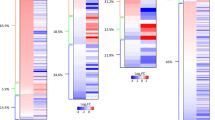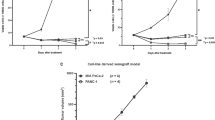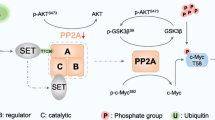Abstract
Hepatocellular carcinoma (HCC) is a common liver cancer often diagnosed at an advanced stage. While chemotherapies such as sorafenib is effective for some patients, others show poor responses, necessitating new treatments. Overexpression of MYCN/NCYM was recently shown to contribute to the development of HCC. This study investigated the effects of Pentagamavunone-1 (PGV-1), a curcumin analog with strong antiproliferative properties, on HCC cells expressing MYCN/NCYM. PGV-1 was more effective than curcumin and sorafenib in inhibiting HCC cell proliferation by inducing mitotic arrest, oxidative stress, and senescence. In MYCN-positive JHH-7 cells, PGV-1 treatment increased phosphorylation of aurora A, cyclin B1, and PLK1. PGV-1 also suppressed MYCN/NCYM transcription and destabilized MYCN protein by inducing phosphorylation at Ser54 and Thr58. In a xenograft model, PGV-1 significantly reduced tumor formation and growth. These findings highlight PGV-1’s potential as a targeted therapy for MYCN-overexpressing HCC, warranting further development.
This is a preview of subscription content, access via your institution
Access options
Subscribe to this journal
Receive 12 print issues and online access
$259.00 per year
only $21.58 per issue
Buy this article
- Purchase on SpringerLink
- Instant access to full article PDF
Prices may be subject to local taxes which are calculated during checkout







Similar content being viewed by others
Data availability
All data generated or analyzed during the present study are included in the article and its supplementary information files.
References
Balogh J, Victor D 3rd, Asham EH, Burroughs SG, Boktour M, Saharia A, et al. Hepatocellular carcinoma: a review. J Hepatocell Carcinoma. 2016;3:41–53.
Yarchoan M, Agarwal P, Villanueva A, Rao S, Dawson LA, Llovet JM, et al. Recent developments and therapeutic strategies against hepatocellular carcinoma. Cancer Res. 2019;79:4326–30.
Imajo K, Fujita K, Yoneda M, Nozaki Y, Ogawa Y, Shinohara Y, et al. Hyperresponsivity to low-dose endotoxin during progression to nonalcoholic steatohepatitis is regulated by leptin-mediated signaling. Cell Metab. 2012;16:44–54.
Knoepfler PS, Kenney AM. Neural precursor cycling at sonic speed: N-Myc pedals, GSK-3 brakes. Cell Cycle. 2006;5:47–52.
Suenaga Y, Kaneko Y, Matsumoto D, Hossain MS, Ozaki T, Nakagawara A. Positive auto-regulation of MYCN in human neuroblastoma. Biochem Biophys Res Commun. 2009;390:21–26.
Chen L, Iraci N, Gherardi S, Gamble LD, Wood KM, Perini G, et al. p53 is a direct transcriptional target of MYCN in neuroblastoma. Cancer Res. 2010;70:1377–88.
Qin XY, Gailhouste L. Non-genomic control of dynamic MYCN gene expression in liver cancer. Front Oncol. 2020;10:618515.
Qin XY, Suzuki H, Honda M, Okada H, Kaneko S, Inoue I, et al. Prevention of hepatocellular carcinoma by targeting MYCN-positive liver cancer stem cells with acyclic retinoid. Proc Natl Acad Sci USA. 2018;115:4969–74.
Qin XY, Su T, Yu W, Kojima S. Lipid desaturation-associated endoplasmic reticulum stress regulates MYCN gene expression in hepatocellular carcinoma cells. Cell Death Dis. 2020;11:66.
Yu J, Ou Z, Lei Y, Chen L, Su Q, Zhang K. LncRNA MYCNOS facilitates proliferation and invasion in hepatocellular carcinoma by regulating miR-340. Hum Cell. 2020;33:148–58.
Sjostrom SK, Finn G, Hahn WC, Rowitch DH, Kenney AM. The Cdk1 complex plays a prime role in regulating N-myc phosphorylation and turnover in neural precursors. Dev Cell. 2005;9:327–38.
Brockmann M, Poon E, Berry T, Carstensen A, Deubzer HE, Rycak L, et al. Small molecule inhibitors of aurora-a induce proteasomal degradation of N-myc in childhood neuroblastoma. Cancer Cell. 2013;24:75–89.
Xiao D, Yue M, Su H, Ren P, Jiang J, Li F, et al. Polo-like kinase-1 regulates Myc stabilization and activates a feedforward circuit promoting tumor cell survival. Mol Cell. 2016;64:493–506.
Dong J, Zhai B, Sun W, Hu F, Cheng H, Xu J. Activation of phosphatidylinositol 3-kinase/AKT/snail signaling pathway contributes to epithelial-mesenchymal transition-induced multi-drug resistance to sorafenib in hepatocellular carcinoma cells. PLoS One. 2017;12:e0185088.
Li Y, Gao ZH, Qu XJ. The adverse effects of sorafenib in patients with advanced cancers. Basic Clin Pharm Toxicol. 2015;116:216–21.
Meiyanto E, Septisetyani EP, Larasati YA, Kawaichi M. Curcumin analog pentagamavunon-1 (PGV-1) sensitizes widr cells to 5-fluorouracil through inhibition of NF-kappaB activation. Asian Pac J Cancer Prev. 2018;19:49–56.
Meiyanto E, Husnaa U, Kastian RF, Putri H, Larasati YA, Khumaira A, et al. The target differences of anti-tumorigenesis potential of curcumin and its analogues against HER-2 positive and triple-negative breast cancer cells. Adv Pharm Bull. 2021;11:188–96.
Meiyanto E, Putri H, Arum Larasati Y, Yudi Utomo R, Istighfari Jenie R, Ikawati M, et al. Anti-proliferative and anti-metastatic potential of curcumin analogue, pentagamavunon-1 (PGV-1), toward highly metastatic breast cancer cells in correlation with ROS generation. Adv Pharm Bull. 2019;9:445–52.
Novitasari D, Kato J, Ikawati M, Putri DDP, Wulandari F, Widyarini S, et al. PGV-1 permanently arrests HepG2 cells in M phase and inhibits liver carcinogenesis in DMH-induced rats. J Appl Pharm Sci. 2023;13:204–11.
Lestari B, Nakamae I, Yoneda-Kato N, Morimoto T, Kanaya S, Yokoyama T, et al. Pentagamavunon-1 (PGV-1) inhibits ROS metabolic enzymes and suppresses tumor cell growth by inducing M phase (prometaphase) arrest and cell senescence. Sci Rep. 2019;9:14867.
Kamitani N, Nakamae I, Yoneda-Kato N, Kato JY, Sho M. Preclinical evaluation of pentagamavunone-1 as monotherapy and combination therapy for pancreatic cancer in multiple xenograft models. Sci Rep. 2022;12:22419.
Moordiani M, Novitasari D, Susidarti RA, Ikawati M, Kato J, Meiyanto E. Curcumin analogs PGV-1 and CCA-1.1 induce cell cycle arrest in human hepatocellular carcinoma cells with overexpressed MYCN. Indonesian Biomed J. 2023;15:141–9.
Novitasari D, Nakamae I, Istighfari Jenie R, Yoneda-Kato N, Kato JY, Meiyanto E. Pentagamavunone-1 inhibits aggressive breast cancer cell proliferation through mitotic catastrophe and ROS-mediated activities: in vitro and in vivo studies. Saudi Pharm J. 2024;32:101892.
Novitasari D, Nakamae I, Yoneda-Kato N, Kato JY, Hippo Y, Suenaga Y, et al. The combination of sorafenib and PGV-1 inhibits the proliferation of hepatocellular carcinoma through c-Myc suppression in an additive manner: in vitro studies. Adv Pharm Pharm Sci. 2024;2024:4297953.
Eberherr C, Beck A, Vokuhl C, Becker K, Haberle B, Von Schweinitz D, et al. Targeting excessive MYCN expression using MLN8237 and JQ1 impairs the growth of hepatoblastoma cells. Int J Oncol. 2019;54:1853–63.
Hu L, Pan X, Hu J, Zeng H, Liu X, Jiang M, et al. Proteasome inhibitors decrease paclitaxel‑induced cell death in nasopharyngeal carcinoma with the accumulation of CDK1/cyclin B1. Int J Mol Med. 2021;48.
Cowley DO, Rivera-Perez JA, Schliekelman M, He YJ, Oliver TG, Lu L, et al. Aurora-A kinase is essential for bipolar spindle formation and early development. Mol Cell Biol. 2009;29:1059–71.
Tillery MML, Blake-Hedges C, Zheng Y, Buchwalter RA, Megraw TL. Centrosomal and non-centrosomal microtubule-organizing centers (MTOCs) in Drosophila melanogaster. Cells 2018;7.
Marumoto T, Honda S, Hara T, Nitta M, Hirota T, Kohmura E, et al. Aurora-A kinase maintains the fidelity of early and late mitotic events in HeLa cells. J Biol Chem. 2003;278:51786–95.
Asteriti IA, De Mattia F, Guarguaglini G. Cross-talk between AURKA and Plk1 in mitotic entry and spindle assembly. Front Oncol. 2015;5:283.
Joukov V, De Nicolo A. Aurora-PLK1 cascades as key signaling modules in the regulation of mitosis. Sci Signal. 2018;11.
Park JG, Jeon H, Shin S, Song C, Lee H, Kim NK, et al. Structural basis for CEP192-mediated regulation of centrosomal AURKA. Sci Adv. 2023;9:eadf8582.
Yu H, Yao X. Cyclin B1: conductor of mitotic symphony orchestra. Cell Res. 2008;18:218–20.
Lindqvist A, van Zon W, Karlsson Rosenthal C, Wolthuis RM. Cyclin B1-Cdk1 activation continues after centrosome separation to control mitotic progression. PLoS Biol. 2007;5:e123.
Allan LA, Camacho Reis M, Ciossani G, Huis In ‘t Veld PJ, Wohlgemuth S, Kops GJ, et al. Cyclin B1 scaffolds MAD1 at the kinetochore corona to activate the mitotic checkpoint. EMBO J. 2020;39:e103180.
Bentley AM, Normand G, Hoyt J, King RW. Distinct sequence elements of cyclin B1 promote localization to chromatin, centrosomes, and kinetochores during mitosis. Mol Biol Cell. 2007;18:4847–58.
Castedo M, Perfettini JL, Roumier T, Valent A, Raslova H, Yakushijin K, et al. Mitotic catastrophe constitutes a special case of apoptosis whose suppression entails aneuploidy. Oncogene. 2004;23:4362–70.
Vitale I, Galluzzi L, Castedo M, Kroemer G. Mitotic catastrophe: a mechanism for avoiding genomic instability. Nat Rev Mol Cell Biol. 2011;12:385–92.
Wu Q, Li Z, Huang Y, Qian D, Chen M, Xiao W, et al. Oxidative stress delays prometaphase/metaphase of the first cleavage in mouse zygotes via the MAD2L1-mediated spindle assembly checkpoint. Oxid Med Cell Longev. 2017;2017:2103190.
Martindale JL, Holbrook NJ. Cellular response to oxidative stress: signaling for suicide and survival. J Cell Physiol. 2002;192:1–15.
Barra V, Chiavetta RF, Titoli S, Provenzano IM, Carollo PS, Di Leonardo A. Specific irreversible cell-cycle arrest and depletion of cancer cells obtained by combining curcumin and the flavonoids quercetin and fisetin. Genes. 2022;13.
Suenaga Y, Yamamoto M, Sakuma T, Sasada M, Fukai F, Ohira M, et al. TAp63 represses transcription of MYCN/NCYM gene and its high levels of expression are associated with favorable outcome in neuroblastoma. Biochem Biophys Res Commun. 2019;518:311–8.
Gregory MA, Hann SR. c-Myc proteolysis by the ubiquitin-proteasome pathway: stabilization of c-Myc in Burkitt’s lymphoma cells. Mol Cell Biol. 2000;20:2423–35.
Otto T, Horn S, Brockmann M, Eilers U, Schuttrumpf L, Popov N, et al. Stabilization of N-Myc is a critical function of Aurora A in human neuroblastoma. Cancer Cell. 2009;15:67–78.
Yang X, Tian X, Zhao P, Wang Z, Sun X. Paclitaxel inhibits hepatocellular carcinoma tumorigenesis by regulating the circ_0005785/miR-640/GSK3β. Cell Biol Int. 2023;47:1170–82.
Okano J, Nagahara T, Matsumoto K, Murawaki Y. The growth inhibition of liver cancer cells by paclitaxel and the involvement of extracellular signal-regulated kinase and apoptosis. Oncol Rep. 2007;17:1195–1200.
Brough D, Amos H, Turley K, Murkin J. Trends in subcutaneous tumour height and impact on measurement accuracy. Cancer Inf. 2023;22:11769351231165181.
Guerin MV, Finisguerra V, Van den Eynde BJ, Bercovici N, Trautmann A. Preclinical murine tumor models: a structural and functional perspective. Elife 2020;9.
Zhu YJ, Zheng B, Wang HY, Chen L. New knowledge of the mechanisms of sorafenib resistance in liver cancer. Acta Pharm Sin. 2017;38:614–22.
Chen C, Okayama H. High-efficiency transformation of mammalian cells by plasmid DNA. Mol Cell Biol. 1987;7:2745–52.
Acknowledgements
We thank Drs. Yoshitaka Hippo and Yusuke Suenaga in the Chiba Cancer Center for their discussions and suggestions, Michiyo Ueno for her technical assistance, and the staff in the Life Science Collaboration Center (LiSCo), NAIST for the support in conducting animal experiments. This research was supported by AMED under Grant Number JP23jm0210092, by JSPS KAKENHI Grant Number JP25K10492 and by the Iida Scholarship Foundation.
Author information
Authors and Affiliations
Contributions
DN, EM, and JyK designed the experiments. DN, IN, and JyK performed the experiments. DN, IN, NYK, EM, and JyK analyzed the data. DN and JyK wrote the manuscript. DN, NYK, EM, and JyK edited the manuscript.
Corresponding author
Ethics declarations
Competing interests
The authors declare no competing interests.
Ethics approval and consent to participate
All methods were performed in accordance with NAIST guidelines and regulations. The experimental protocols used in the present study were approved by the NAIST Institutional and Licensing Committees (reference number 1805). The study is reported in accordance with ARRIVE guidelines.
Additional information
Publisher’s note Springer Nature remains neutral with regard to jurisdictional claims in published maps and institutional affiliations.
Rights and permissions
Springer Nature or its licensor (e.g. a society or other partner) holds exclusive rights to this article under a publishing agreement with the author(s) or other rightsholder(s); author self-archiving of the accepted manuscript version of this article is solely governed by the terms of such publishing agreement and applicable law.
About this article
Cite this article
Novitasari, D., Nakamae, I., Yoneda-Kato, N. et al. Pentagamavunone-1 targets excessive MYCN/NCYM expression mediated by mitotic arrest to suppress hepatocellular carcinoma proliferation. Cancer Gene Ther (2025). https://doi.org/10.1038/s41417-025-00956-y
Received:
Revised:
Accepted:
Published:
DOI: https://doi.org/10.1038/s41417-025-00956-y



